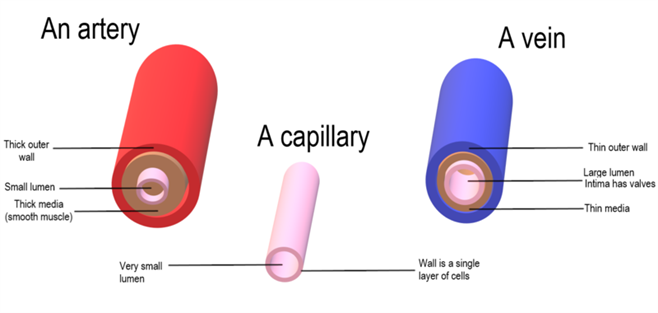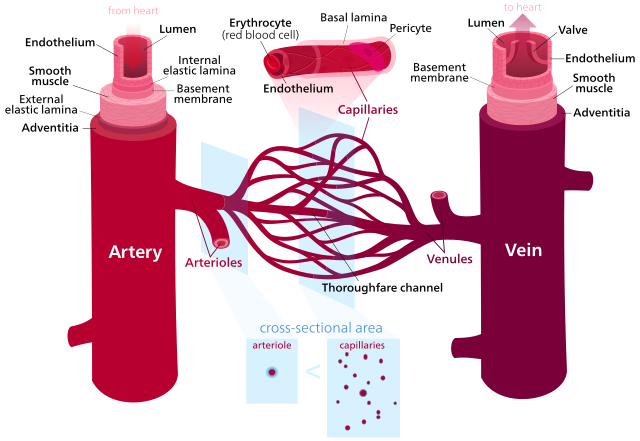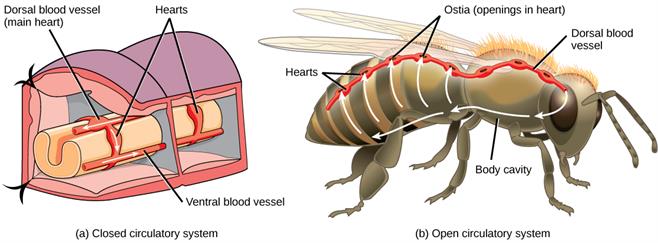
PUMPA - SMART LEARNING
எங்கள் ஆசிரியர்களுடன் 1-ஆன்-1 ஆலோசனை நேரத்தைப் பெறுங்கள். டாப்பர் ஆவதற்கு நாங்கள் பயிற்சி அளிப்போம்
Book Free DemoIn the previous theories, we discussed blood, blood components, and the role of blood in transportation. How is the blood distributed to body tissues?
The blood vessels are a network of branched tubes that supplies blood throughout the body of an organism. There are three types of blood vessels which include:
1. Arteries
2. Veins
3. Capillaries
Arteries:
Arteries are the thick and elastic vessels that carry oxygenated blood away from the heart to the different parts or organs of the body.
Arteries have elastic and thick walls as blood emerges from the heart under high pressure. They are narrow in size as the blood flows quickly through them.
Important!
All arteries carry oxygenated blood except the pulmonary artery, which carries deoxygenated blood to the lungs.
Veins:
Veins are thin and non-elastic vessels that carry deoxygenated blood to the heart from the different organs.
Since the veins collect blood from the various body parts, they are wider. Veins do not have thick walls as the blood is not under pressure. They have valves that prevent the backward flow of blood.
Important!
All veins carry deoxygenated blood except the pulmonary vein, which carries oxygenated blood from the lungs to the heart.
Histology of vessels:
The walls of the artery and veins comprise of \(three\) coats:
1. Tunica externa - outermost coat formed by the connective tissues. They are also called tunica adventitia.
2. Tunica media - middle layer formed by elastic connective tissue and smooth muscle fibres.
3. Tunica intima - innermost coat.
Lumen is the innermost space lined by the endothelium of tunica interna.

Internal structure of artery and vein
Capillaries:
Capillaries are narrow tubes formed due to the branching of arterioles that unites to form venules and veins. Capillaries are about \(8\) \(m\) in diameter and are the smallest vessel.
They are formed of a single layer of endothelial cells. The thin wall of capillaries allows the exchange of substances between the blood and the surrounding cells. The capillaries combine to form veins that carry blood around the body.

Transport of blood between artery and vein through capillaries
Difference between artery and vein:
S.No | Artery | Vein |
1. | Arteries are distributing vessels. | Veins are collecting vessels. |
2. | They are pink in colour. | They are red in colour. |
3. | Arteries are present in deep locations. | Veins are present in superficial locations. |
4. | In arteries, blood flows with high pressure. | In veins, blood flows with low pressure. |
5. | The walls of an artery are strong, thick, and elastic. | The walls of a vein is weak, thin, and non-elastic. |
6. | All arteries carry oxygenated blood except pulmonary arteries. | All veins carry deoxygenated blood except pulmonary veins. |
7. | In arteries, internal valves are absent. | In veins, internal valves are present. |
Types of circulatory system:
1. Open type
2. Closed type

Open and closed circulatory systems
Open circulatory system:
In the open circulatory system, blood pumped by the heart passes through blood vessels into open blood spaces, or body cavities called sinuses. These sinuses are the body cavities that are called haemocoel. Capillaries are absent in an open circulatory system.
Example:
Invertebrates like arthropods, ascidians and molluscs have an open circulatory system.
Closed circulatory system:
In the closed circulatory system, blood pumped by the heart flows in a complete circuit in the body through specific blood vessels. Blood is circulated through a closed network of blood vessels. The blood flows from arteries to veins through small blood vessels called capillaries.
Example:
Annelids and all the vertebrates have a closed circulatory system.
Reference:
https://commons.wikimedia.org/wiki/File:Artery_Vein_Capillary_Comparison.png
https://commons.wikimedia.org/wiki/File:Blood_vessels-en.svg
https://upload.wikimedia.org/wikipedia/commons/4/45/Figure_40_01_01ab.jpg